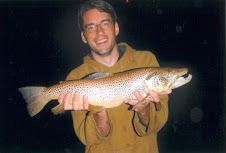Truly, the honey hole is a fisherman's holy grail. One can never have enough of them, and those held under hat over time allow for a true understanding of the river and its ever-changing nature. For me, I have found several different holes on different rivers and streams that would fall into the "honey hole," category. One in particular, however, stands out in the forefront of my mind. A close-lipped secret between my dad, myself, and some very close friends, we cherish this particular spot because of the indelible memories made there.
The spot gained its lore before I even fished it. When my dad used to talk about it, his voice would lower and he would get what I would describe as a twinkle in his eye. He would also get very serious. I never knew why he did this when I was younger, but as I grew older I soon understood.
Numerous fish over 18" have come out of the hole. When I was younger, my dad would usually bag a big fish out of the hole, and then he always told me about the story which involved him, the hole, and landing three trout over 18" without moving more than five steps. I caught my first 20"+ brown out of this hole. Trout slurped Sulphurs by the clumps i
n this hole. I landed an enormous brown trout, longer than my 24" net,
in this hole. I love this run. A heavy riffle used to give way to a long slick, in which monster fish would rise. Since I could wade up from the nearest public access, I spent the vast majority of my fishing time here.
Now, don't get me wrong, its definitely a sizable walk from the nearest access. After all, that is probably why the fishing was so good there and the fact that it was almost always open. Fortunately, the folks that lived nearby were not fisherman, and the fish there were relatively unpressured.
I watched this hole evolve practically since my flyfishing obsession started. At first, there was a huge log jam that had "stuck" itself to the the south bank of the run. Untold 18 + inch brown trout lived under the jam, natures version of a man-made "trout hotel." After the jam washed out during a high-water event, my dad and I assumed the fishing would drop off, but it only got better. I have seen numerous jams move in and out of the hole since my introduction to it.
One year, about three years ago, I noticed something very different about the hole. Where one of my favorite eddies and a good brook trout spot was once located, it was now slackwater. As I looked closer, I saw that massive man-made "trout hotels," were put in spots that had essentially channelized the river. As nearby property changed hands, I noticed more and more of the man-made structure in unfortunate spots. Where I used to wade on small pebbles, I now waded in foot-deep muck. The man-made structures have ruined my run.
By and large, these structures have vastly improved both the Au Sable and Manistee river systems. For the most part they are put in good areas that attract not just trout, but large trout. In this case, however, I wish I would have known about the changes that were to be made in the name of trout habitat.
I have not given up on my honey hole. I still spend a lot of time here, but unfortunately most of it is spent reminiscing about past times. Trout still live here, and I am sure that it will someday be restored to its former glory. I just hope that I'm sitting on the bank when it does...











